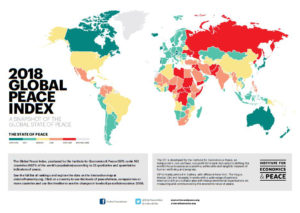Dream of world peace slipping away
 The number of refugees fleeing conflicts has soared to 1 percent of the world’s total population, the highest level in modern history, according to a new report.
The number of refugees fleeing conflicts has soared to 1 percent of the world’s total population, the highest level in modern history, according to a new report.
The 2018 Global Peace Index shows the world is less peaceful now than at any time in the last 10 years with terrorism and internal conflict the two biggest contributors.
The conflict has pushing down the 2018 peace index figure down for the fourth year in a row.
According to the index and its ancillary report, published by the New York-based Institute of Economics & Peace, Iceland retained the top spot as the world’s most peaceful country while Syria was the least peaceful for the fifth straight year.
“Increased numbers of refugees, terrorism, and heightened political tensions were behind the deterioration,” Steve Killelea, the institute’s founder told media.
“Refugees on their own would make one of the world’s biggest nations,” Mr Killelea said
There were 65.6 million refugees, or internally displaced people, at the end of 2016, or about 1 percent of the world population, the report said.
More than 55 per cent of them come from Syria, Afghanistan, and South Sudan, according to the United Nations High Commission on Refugees, on whose data the report is based.
While the vast majority of refugees are housed in neighboring countries, the flow of people fleeing conflicts or poverty in Africa or the Middle East to Europe has empowered nationalist parties across the continent, the report said.
The five most peaceful nations in the world last year were Iceland, New Zealand, Austria, Portugal and Denmark, unchanged from the previous year.
There was also no change in the bottom slots held by Syria, Afghanistan, South Sudan, Iraq, and Somalia. There were 92 countries whose ranking deteriorated and 71 that improved.
Worldwide, the economic impact of violence was estimated at $14.8 trillion in 2017, up 2 percent from the previous year and equal to 12.4 percent of global output or about $2,000 a person.
“Peace is not just about ending human suffering, but also economic opportunity,” Mr Killelea said
“Countries at the bottom of the list get caught in a terrible downward cycle,” he said.
“The Global Peace Index 2018 report finds that the global level of peace has deteriorated by 0.27% over the last year,” the report said.
“This is the fourth successive year of deterioration, finding that 92 countries have deteriorated, while 71 countries have improved,” it said.
The report reveals a world in which tensions, conflicts and crises that have emerged over the past decade remain unresolved, causing a gradual, sustained decline in global levels of peacefulness.
Other major findings were: 92 countries deteriorated whilst 71 countries improved between 2016 and 2017; countries that improved in peace over the last decade had seven times higher GDP growth rates; military expenditure compared to country GDP has been steadily falling in more countries than increasing; and, battle deaths have risen steadily over the last 10 years, increasing by 264 per cent.
The report also found both Europe and North America become less peaceful, with 23/36 countries in Europe deteriorating last year. And, sub-Saharan Africa was home to four of the five largest improvements in peacefulness.
Laurie Nowell
AMES Australia Senior Journalist












